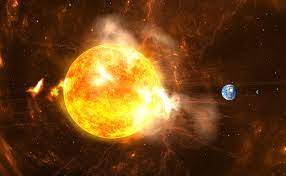Buckle up, space enthusiasts! The Sun is putting on a cosmic fireworks show, and NASA solar flares are stealing the spotlight. Just hours ago, on May 19, 2025, NASA’s Solar Dynamics Observatory captured a surprise M3.2 flare erupting from an unseen sunspot on the Sun’s northeast edge. This moderate burst caught forecasters off guard, hinting at more solar shenanigans to come. With the Sun’s most active region now facing Earth, the stakes are high—think auroras painting the skies and potential radio blackouts. Let’s dive into the sizzling world of NASA solar flares and unpack what’s happening up there.
NASA Solar Flares: A Week of Cosmic Fireworks
The past week has been a wild ride for solar activity. On May 14, a massive X2.7 flare—the strongest of 2025—blasted from sunspot region AR4087, triggering radio blackouts across Europe, Asia, and the Middle East. NASA’s observatories, including the Solar Dynamics Observatory, recorded the event in stunning detail, showing a bright flash and shifting coronal field lines. This flare, peaking at 4:25 a.m. ET, was no small fry—it caused rapid ionization in Earth’s upper atmosphere, disrupting high-frequency radio signals. Just a day earlier, an X1.2 flare on May 13 added to the chaos, proving the Sun is in a feisty mood during its solar maximum phase.
What makes these NASA solar flares so fascinating? They’re not just bursts of light. These explosions release high-energy radiation and sometimes coronal mass ejections (CMEs)—clouds of charged particles that can slam into Earth’s magnetic field. When that happens, we get dazzling auroras but also risks to power grids, satellites, and navigation systems. The Met Office predicts auroras over the UK and Ireland by May 22, thanks to these solar outbursts. NASA’s real-time monitoring is our front-row seat to this cosmic drama.
Why NASA Solar Flares Matter Now
Why should you care about NASA solar flares? Because they’re more than pretty lights—they’re a wake-up call. The X2.7 flare from AR4087, followed by an M5.3 flare hours earlier, shows this sunspot is a troublemaker. As it rotates toward Earth, scientists warn of more disruptions. A May 16 report from the European Space Agency highlighted a near-miss “bird wing” eruption that could’ve hit Earth, causing widespread blackouts. NASA’s data suggests these flares are part of Solar Cycle 25, which peaked in late 2024 but is still delivering surprises.
Here’s a quick breakdown of recent NASA solar flare impacts:
- Radio Blackouts: X2.7 flare disrupted signals across three continents.
- Auroras: CMEs could light up skies as far south as the UK.
- Satellite Risks: High-energy particles threaten spacecraft electronics.
- Power Grids: Geomagnetic storms could strain electrical systems.
NASA’s Solar Dynamics Observatory and NOAA’s Space Weather Prediction Center are working overtime to track these events, giving us critical warnings. But predicting flares is tricky—new research from March 2025 shows flickering coronal loops might signal flares hours in advance, a game-changer for preparedness.
The Science Behind the Spectacle
Ever wonder what fuels NASA solar flares? It’s all about the Sun’s magnetic mayhem. Sunspots, like AR4087, are regions of intense magnetic activity where energy builds up and explodes as flares. X-class flares, the most powerful, pack a punch 10 times stronger than M-class ones. NASA’s observatories capture these in wavelengths like 171 and 131 angstroms, revealing plasma arcs and magnetic field shifts. The M3.2 flare on May 19 hinted at a possible CME, which could mean auroras or geomagnetic storms by mid-week.
What’s next? Scientists are eyeing AR4087 and new sunspots for more activity. Posts on X from @NASASun and @RyanJFrench confirm the Sun’s eastern limb is buzzing, with AR14087 quieter but still unpredictable. The Sun’s not done surprising us, and NASA’s real-time data is our best guide.
Stay in the Loop!
Want to keep up with NASA solar flares? Follow NASA’s Solar Dynamics Observatory updates and check NOAA’s Space Weather Prediction Center for alerts. Share your aurora pics or thoughts in the comments—what’s the wildest space weather you’ve seen? Stay curious, and let’s keep exploring the Sun’s fiery temper together!
